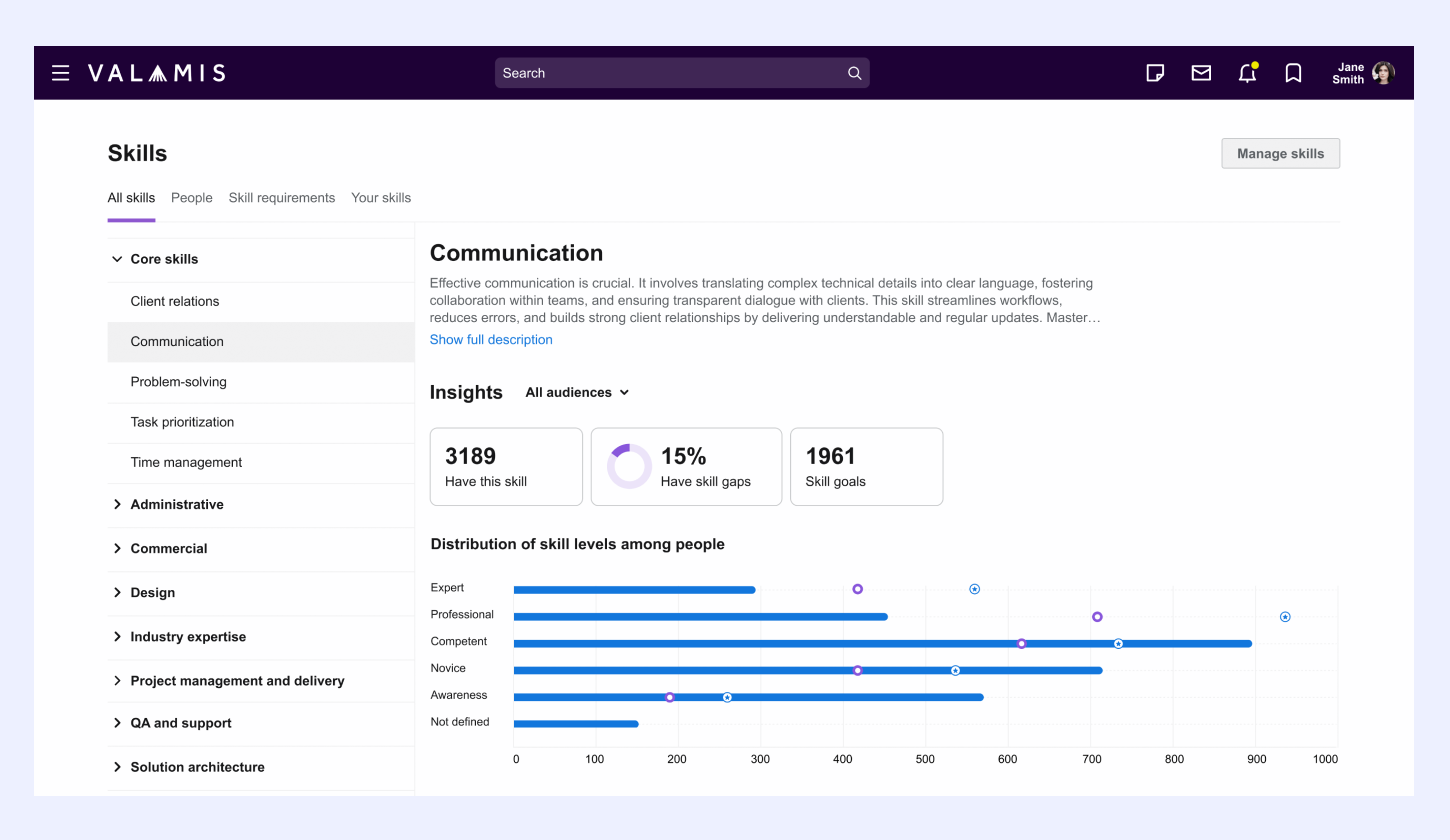Cross-training employees: A smarter way to build agility and engagement
Let’s take a look at what cross-training is, why it matters, how to build an effective program, and how real companies are making it work.

Cross-training employees should never be thought of as a siloed backup plan for decreasing absences or turnover. Done right, it’s a way to build agility, raise morale, and uncover hidden talent in your organization.
In this guide, we’ll walk you through what cross-training is, why it matters, how to build an effective program, and how real companies like yours are making it work.
Whether you’re in HR, L&D, or team leadership, you’ll leave with a clearer picture and actionable steps.
What is cross-training in the workplace?
Cross-training in the workplace means teaching employees to do tasks outside their usual responsibilities. Unlike job rotation, which moves people through various roles over time, cross-training is more strategic: it helps people learn adjacent skills while staying in their core roles. It’s not about multitasking or piling on more work, but focused on developing a more flexible, capable workforce that can adapt to change, cover key functions when needed, and grow in their careers.
Think of cross-training as a form of employee skills development. When you invest in broadening someone’s capabilities, you’re also helping them see new paths forward (not just upward).
Benefits of cross-training employees
If you’re thinking about launching a cross-training plan, you probably want to understand what’s in it for your organization and your people. Let’s break down the benefits of cross-training employees from both angles:
Cross-trained teams can adapt quickly when someone is out or when priorities shift. For example, a customer support agent who’s also familiar with basic billing processes can step in to help during a peak. This flexibility raises overall team agility, avoids unnecessary delays, and improves customer satisfaction.
It also has a positive effect on collaboration. When employees understand each other’s roles and challenges, they tend to work together more effectively. This often leads to better cross-functional communication and fewer misunderstandings.
Here are a few more ways cross-training delivers value:
- Increases employee engagement: People are more likely to stay when they’re learning something new.
- Encourages internal mobility: Employees can transition into new roles more easily.
- Strengthens leadership pipelines: You get a clearer picture of who’s ready to step up.
- Promotes problem-solving: Teams with broader skillsets handle challenges more creatively.
A LinkedIn Learning survey showed that 94% of employees would stay longer at companies that invest in their growth. Cross-training is one way to make that investment feel real.
Pros and cons of cross-training employees
No strategy is without its challenges. Cross-training can be very useful, but it also requires careful planning.
On the plus side, it creates a more collaborative environment where people have empathy for each other’s workloads. It also creates backup coverage and reduces knowledge silos. Your team becomes more adaptable and less reliant on any single person.
That said, watch out for a few common drawbacks:
- Role confusion: Without clarity, employees might overstep or duplicate efforts.
- Time constraints: Training someone new takes time, which can be hard to spare.
- Risk of overload: Adding responsibilities without removing others can lead to burnout.
- Uneven implementation: If some teams buy in and others don’t, it can create an imbalance.
That’s why it’s critical to communicate the purpose and limits of cross-training from the start. It should feel like an opportunity, not an obligation.

How to conduct a skills gap analysis and what to do next
Start building your foundation for strategic workforce development.
Download guideHow to mitigate cross-training problems
To avoid these pitfalls, HR and L&D teams need to take a strategic, data-informed approach.
First, identify the areas with the biggest overlap or bottlenecks using a skills gap analysis. Then work closely with team leads to decide who should be cross-trained and why. Make sure everyone understands what the training involves and how it fits into their regular responsibilities.
Using a learning platform can help reduce scheduling friction. For example, if you deliver microlearning modules asynchronously, people can complete training without it interfering with peak work periods. Reminders, peer coaching tools, and clear learning paths help keep everyone on track without adding too much pressure.
How to design an effective cross-training program
A good cross-training program for employees starts with clarity and grows through iteration.
Instead of listing every step, think of it as a design loop. Start by mapping out interdependent roles. For instance, if your sales and customer success teams work closely together, consider building mutual awareness of their tools, processes, and customer pain points. A few targeted sessions or shadowing opportunities can go a long way.
Next, use a skills matrix to pinpoint gaps. This doesn’t have to be complex, a simple table showing who knows what can be eye-opening.

Once you know what’s missing, set learning goals. These should be practical and measurable. For example, if you’re cross-training a marketer in basic CRM use, the goal might be: “Able to pull and interpret basic campaign performance data.”
Here’s what a well-balanced cross-training plan might include:
- Peer learning: Have employees shadow each other or co-own a project.
- Microlearning modules: Short, targeted content that’s easy to consume on the job.
- Scenario-based training: Interactive lessons using real business challenges.
- Stretch assignments: Let employees test new skills in a safe, low-risk environment.
From there, design your cross-training plan. Combine structured learning with informal peer exchange. Mix in job shadowing, real-world tasks, or short collaborative projects. If you’re using an LMS like Valamis or 360Learning, you can automate reminders and offer interactive check-ins.
Don’t forget to follow up. Ask what worked, what didn’t, and whether the learning actually transferred to the job. You can use learning analytics to spot patterns. If people are dropping off halfway through a module, something needs to change.
And remember: cross-training is most powerful when it’s treated as part of the learning culture, not a side project.
Cross-training employees examples
Let’s bring this to life with a few cross-training employees examples:
One example comes from Vaillant, a well-known manufacturer that manages to train people across many countries. With so many different learner groups to unify, they used audiences and learning paths to help developers, designers, and project leads understand each other’s roles and workflows. This not only improved collaboration but also reduced the time it took for new hires to get up to speed.
Another comes from a study by AIHR, which found that structured cross-training can reduce time-to-productivity by 25%. That’s a significant increase in efficiency, especially during periods of transition or rapid growth.
In the public sector, the U.S. Government Accountability Office reported that cross-training key finance personnel helped agencies continue operating smoothly during periods of staffing shortages. It’s a reminder that continuity planning is not only a private-sector concern.
Here’s how these strategies often play out:
- Increased trust between departments: Cross-trained staff collaborate more effectively.
- Reduced turnover: Employees see more career possibilities internally.
- Faster onboarding: New hires benefit from broader team knowledge.
- Business continuity: Teams stay productive during disruptions.
Final thoughts: Cross-training that works
Cross-training employees is about flexibility yes, but also consider the opportunities it brings. For your people, it opens doors. For your company, it builds strength. When designed with care and backed by data, it becomes more than a workaround; it becomes a strategy.
Whether you’re just starting to sketch your cross-training plan or refining one that already exists, tools like Valamis can help you scale it, personalize it, and measure what matters. And if you’re ready to see how skills-based development fuels real progress, you’re not alone. Start where you are – and grow from there.




